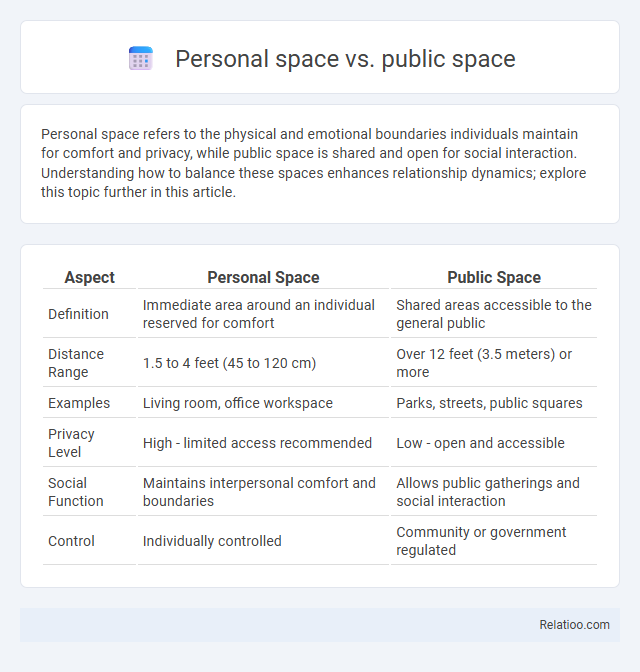Personal space refers to the physical and emotional boundaries individuals maintain for comfort and privacy, while public space is shared and open for social interaction. Understanding how to balance these spaces enhances relationship dynamics; explore this topic further in this article.
Table of Comparison
| Aspect | Personal Space | Public Space |
|---|---|---|
| Definition | Immediate area around an individual reserved for comfort | Shared areas accessible to the general public |
| Distance Range | 1.5 to 4 feet (45 to 120 cm) | Over 12 feet (3.5 meters) or more |
| Examples | Living room, office workspace | Parks, streets, public squares |
| Privacy Level | High - limited access recommended | Low - open and accessible |
| Social Function | Maintains interpersonal comfort and boundaries | Allows public gatherings and social interaction |
| Control | Individually controlled | Community or government regulated |
Understanding Personal Space: Definition and Importance
Personal space refers to the physical distance individuals maintain to feel comfortable and secure, typically ranging from 18 inches to 4 feet depending on cultural norms and social context. Public space encompasses areas accessible to everyone, such as parks and streets, where social interactions require adapting to reduced personal space, often less than 18 inches. Understanding personal space is crucial for fostering respectful communication, preventing discomfort, and ensuring psychological well-being in both private and public environments.
What Constitutes Public Space? Key Characteristics
Public space constitutes areas accessible to all individuals without restrictions, including parks, streets, squares, and transit hubs. These spaces are characterized by openness, communal use, and regulatory oversight to ensure safety and inclusivity. Your interaction within public spaces is governed by social norms and legal frameworks designed to balance individual freedom with collective order.
Cultural Differences in Personal and Public Space
Cultural differences significantly influence perceptions of personal and public space, affecting social interactions and comfort levels. In collectivist societies, personal space tends to be smaller, with closer physical proximity accepted in public areas, while individualistic cultures often prioritize larger personal bubbles to maintain privacy. Understanding these variations helps you navigate social environments respectfully and effectively, avoiding misunderstandings.
The Psychology Behind Spatial Boundaries
Spatial boundaries play a critical role in human psychology by regulating comfort, social interaction, and autonomy. Personal space functions as an invisible buffer zone around an individual that, when invaded, triggers stress and defensive behavior, whereas public space accommodates large groups and encourages social engagement without the need for intimacy. Understanding these distinctions highlights how the brain processes spatial cues to maintain a balance between connection and privacy, essential for mental well-being and effective communication.
Personal Space in Urban Environments
Personal space in urban environments is the physical and psychological buffer individuals maintain to feel secure and comfortable amid dense populations. This spatial boundary helps manage social interactions, reduce stress, and preserve privacy despite the constant presence of diverse public spaces like parks, streets, and plazas. Effective urban design prioritizes personal space through elements such as seating arrangements, green buffers, and controlled pedestrian flow to enhance well-being and social harmony.
Public Space and Community Interaction
Public space serves as a vital platform for community interaction, fostering social connections and cultural exchange. Your engagement in shared environments like parks, plazas, and streets encourages inclusivity and collective well-being. Balancing personal space within these public domains ensures respect for individual boundaries while promoting active participation in communal life.
Technology’s Impact on Personal and Public Boundaries
Technology blurs the lines between personal space and public space by enabling constant connectivity through smartphones, social media, and location tracking. Your personal boundaries are often challenged as digital devices create overlapping zones where private information can be accessed or shared unintentionally. Advances in surveillance, smart home devices, and public Wi-Fi networks contribute to redefining privacy norms and spatial boundaries in everyday life.
Legal Aspects: Rights in Personal and Public Spaces
Legal rights in personal spaces typically afford individuals greater privacy protections under laws such as the Fourth Amendment in the United States, which guards against unreasonable searches. Public spaces, however, have limited privacy rights, allowing government authorities and individuals to monitor and record activities with fewer restrictions. Understanding these distinctions is crucial for navigating legal boundaries related to surveillance, trespassing, and free expression in varying spatial contexts.
Navigating Conflicts Between Private and Public Spaces
Navigating conflicts between private and public spaces requires understanding the distinct boundaries of personal space, defined by individual comfort zones, and public space, characterized by shared accessibility. Effective conflict resolution involves respecting privacy rights, implementing clear regulations, and promoting community awareness to balance personal freedom with collective interests. Strategies such as designated quiet zones, privacy shields, and conflict mediation can mitigate tensions and foster coexistence in overlapping environments.
Future Trends: Evolving Concepts of Space in Society
Future trends in personal, public, and private spaces emphasize adaptive designs that prioritize your comfort, privacy, and social interaction through smart technology integration and flexible layouts. Innovations in urban planning and architecture aim to balance accessibility and personalization by creating multifunctional environments that respond to individual needs and collective activities. These evolving concepts shape a society where spatial boundaries are fluid, enhancing wellbeing and connectivity in dynamic ways.

Infographic: Personal space vs Public space
 relatioo.com
relatioo.com